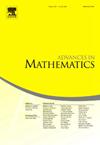Grothendieck shenanigans: Permutons from pipe dreams via integrable probability
IF 1.5
1区 数学
Q1 MATHEMATICS
引用次数: 0
Abstract
We study random permutations corresponding to pipe dreams. Our main model is motivated by the Grothendieck polynomials with parameter arising in the K-theory of the flag variety. The probability weight of a permutation is proportional to the principal specialization (setting all variables to 1) of the corresponding Grothendieck polynomial. By mapping this random permutation to a version of TASEP (Totally Asymmetric Simple Exclusion Process), we describe the limiting permuton and fluctuations around it as the order n of the permutation grows to infinity. The fluctuations are of order and have the Tracy–Widom GUE distribution, which places this algebraic (K-theoretic) model into the Kardar–Parisi–Zhang universality class. As an application, we find the expected number of inversions in this random permutation, and contrast it with the case of non-reduced pipe dreams.
Inspired by Stanley's question for the maximal value of principal specializations of Schubert polynomials, we resolve the analogous question for Grothendieck polynomials, and provide bounds for general β. This analysis uses a correspondence with the free fermion six-vertex model, and the frozen boundary of the Aztec diamond.
格罗滕迪克诡计:通过可积概率从白日梦中置换
我们研究与白日梦相对应的随机排列。我们的主要模型是由旗变k理论中出现的参数为β=1的Grothendieck多项式驱动的。排列的概率权重与相应的Grothendieck多项式的主专门化(将所有变量设置为1)成正比。通过将这种随机排列映射到TASEP(完全不对称简单排除过程)的一个版本,我们描述了当排列的n阶增长到无穷大时的极限排列及其周围的波动。涨落为n13阶,并具有Tracy-Widom GUE分布,使该代数(k -理论)模型属于kardar - paris - zhang普适性类。作为一个应用,我们找到了这种随机排列中反转的期望数目,并将其与非约简白日梦的情况进行了对比。受Stanley关于Schubert多项式的主专门化极大值问题的启发,我们解决了β=1 Grothendieck多项式的类似问题,并给出了一般β的界。这种分析使用了与自由费米子六顶点模型的对应关系,以及阿兹特克钻石的冻结边界。
本文章由计算机程序翻译,如有差异,请以英文原文为准。
求助全文
约1分钟内获得全文
求助全文
来源期刊

Advances in Mathematics
数学-数学
CiteScore
2.80
自引率
5.90%
发文量
497
审稿时长
7.5 months
期刊介绍:
Emphasizing contributions that represent significant advances in all areas of pure mathematics, Advances in Mathematics provides research mathematicians with an effective medium for communicating important recent developments in their areas of specialization to colleagues and to scientists in related disciplines.
 求助内容:
求助内容: 应助结果提醒方式:
应助结果提醒方式:


